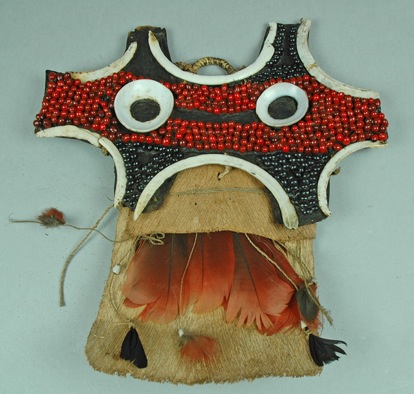Warrior’s ornament
Papua New Guinea
 Donated by Miss E.E. Gage-Brown, 1933; 1933.40.24This ornament from Papua New Guinea is made of turtleshell that has been covered with red and black abrus seeds and edged with boar's tusks. Attached to the bottom of this central plate is a piece of plant spathe decorated with tropical bird feathers.
Donated by Miss E.E. Gage-Brown, 1933; 1933.40.24This ornament from Papua New Guinea is made of turtleshell that has been covered with red and black abrus seeds and edged with boar's tusks. Attached to the bottom of this central plate is a piece of plant spathe decorated with tropical bird feathers.
Made for and by a man, this type of ornament was normally slung around the neck, worn hanging down the chest or back. During fighting, however, it could be held between the teeth by means of a small strap on the reverse, so it dangled malevolently from the mouth. The two shell 'eyes' on the ornament probably served to underline the warrior's fierceness. In general in Melanesia, men were traditionally more adorned than women and this ornament was not worn in isolation but as part of an ensemble incorporating a headdress, weapons, and bright face and body paint.
Made by the Koiari people of the mountainous Central Province area of New Guinea, this object reflects the art and design of that region which is dominated by geometric motifs, which also appear in tattoo patterns. However, this type of ornament is not exclusive to the Koiari. The Keveri people, from south-east had a fighting ornament which was held in the mouth similar to this one. The Abelam and Wosera people too, of the Sepik River regions, also wore a similar ornament when dancing although with larger, less worked boar's tusks which curved upwards and partly covered the face.
Boar's tusks were often used in Papuan ornaments and were also worn on their own as pendants. The boar was an aggressive animal and the wearing of the animal's tusks on the face allowed the wearer to access the its power when fighting. Both domestic pigs, which were the most valuable of livestock, and wild pigs have these curving tusks.
